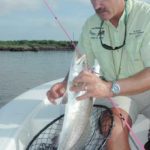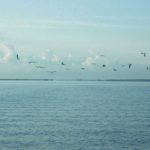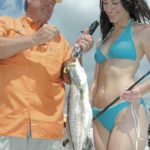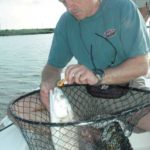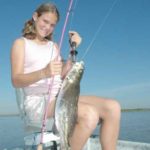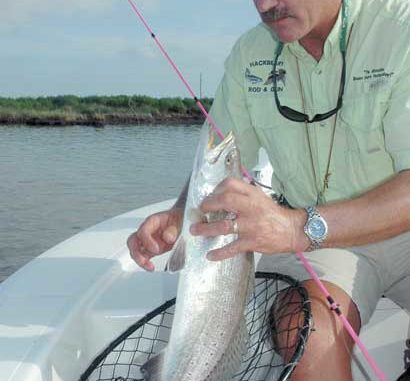
If you want to catch school trout, get out in the middle of Calcasieu Lake, but if you’re after the famous lunkers, there’s no better place to be than the shorelines.
As the Mister Twister Exude RT Slug twitched and darted just under the surface, I saw an explosion. Instantly, I set the hook and listened to my drag sing the sweet music of hooking up with a monster trout. My pink rod curled under the hard-charging pressure of the big fish.From behind me, I heard Kirk Stansel of Hackberry Rod and Gun coaching, “Don’t horse the trout, and lose it, John. Let it run, and stay calm. That’s why I’ve got the drag on your rod set so loose. That’s the picture fish you’ve been wanting. Take your time, and enjoy the fight.”
Although I’ve fished all my life, I generally can’t remain calm and let a big trout run. The fear of losing a trout that will weigh 6 or 7 pounds often takes precedence over common sense and angling skill. That’s why I appreciate a coach who preaches while I’m trying to maintain my composure and get a heavyweight speckled trout to the boat.
When the big, burnt-yellow-mouthed toothy trout raised its head, dove for the bottom and then went under the boat, I nearly panicked.
But Stansel didn’t.
“Kneel down, and put your rod tip under the water to keep the line from touching the boat,” he said.
Finally, the big trout rolled near the side of the boat, and Stansel netted it.
Nothing’s quite as exciting as catching a lunker speckled trout, and you’ll have plenty of opportunities to catch a fish that size this month at Lake Calcasieu. This area still is seeing the positive effects on its fishing from Hurricane Rita 3 years ago.
“By fishing under the birds and drifting the reefs, you can catch and release 50 to 100 trout in a day and keep a limit of the ones you want to eat,” Stansel said. “But when you’re fishing for trophy trout, the game changes, and the numbers can decrease.”
During Rita, a 9-foot surge, powered by 100- to 150-mph winds that pushed water through the Hackberry Rod and Gun buildings, wiped out the dock, the lodge and everything else that stood in its way and caused a fish kill. But when the organic matter from the bank flushed back into the lake and started to decay, Calcasieu experienced a rebirth with more rich and fertile water than it had seen in previous years.
“Although we lost everything at Hackberry Rod and Gun during Hurricane Rita, there was a tremendous amount of dying and rotting vegetation in the water, which stimulated the baitfish and the shrimp,” Stansel said. “Then we saw large numbers of speckled trout and redfish and some of the biggest speckled trout and redfish we’d seen in recent years.”
Area anglers consider June the peak month for the big trout to congregate in the shallow waters around Calcasieu, and regularly will catch 7- to 9-pound trout then. On some days, you may only catch one trout this size, and on other days, you may catch three or four trout, if you fish for big trout instead of schooling trout.
Find, catch trophies
“To catch big trout, fish the shorelines in June,” Stansel advises.
Although you can catch a big trout anywhere in Calcasieu, Stansel believes the larger trout feed on the bigger baitfish like the mullet that move along the mud flats of the shoreline, and hold closer to the shoreline than the smaller baitfish like shrimp and menhaden do that prefer the open bay.
Anytime you’re fishing under the birds or drifting the oyster reefs, you can pick up big trout. If you want to target only big trout, you’ll get fewer bites. On the shoreline, you may not catch your limit, but you will take bragging-sized trouts and reds.
Stansel recommends you fish the areas where you normally catch redfish for opportunities at big trout.
“The big fish prefer to eat bigger baits because they expend less energy, get more food and don’t have to chase the baits a long distance,” he said.
You can take big trout 20- to 30-inches long early in the morning on a slick, calm day on big baits. Stansel prefers the Exude RT Slug and topwater lures like the MirrOlure She Dog and the Corky, a handmade lure from Texas. Later in the morning, Stansel will fish Mr. Twister grubs, Mepps spoons and spinners and the Mister Twister Exude Slimy Slug, an deadly muddy-water lure.
“I fish 12-pound-test line with 2 or 3 feet of 30-pound-test leader to which I attach my main line with a surgeon’s knot,” Stansel said. “Because we fish around oyster shells and the big speckled trout have sharp teeth in their mouths, I prefer to fish the heavier leader to give my fishermen some protection against losing a big trout.”
On an average day, a party fishing the shoreline out of Hackberry may catch 15 to 25 nice-sized trout and generally a limit of redfish, plus they can catch-and-release another 25 to 50 specks and reds during the day.
“If each customer catches 10 to 12 trout that will weigh from 3 to 9 pounds each and a limit of redfish that will weigh from 3 to 9 pounds each, we’ve had a very good day,” Stansel said.
Big trout bite
Until we can get into the mind of a speckled trout, we won’t know for sure exactly what stimulates its hunger. However, over the years, the guides at Hackberry have learned that water clarity, wind speed, the availability of bait in the water and the speed at which they work their lures all combine to make big trout bite.
“If the water’s clear, then speed up your retrieve,” Stansel recommends. “In June, our water temperature is hitting the 80-degree mark, so I work my baits really quickly. I get more strikes on a fast-moving bait than a slow-moving bait then. If the water’s muddy, I slow down my retrieve.”
Many anglers fail to understand that a big trout, much like a big, older-class white-tailed deer, has lived for a while, so it knows what fishermen do and how they sound. Your quietness in approaching the shoreline means you’ll catch more trout.
“When I reach the shoreline I want to fish, I stop my boat 200 or 300 yards short of where I’ll start fishing,” Stansel said. “I try and use the wind or the tide to get me to the spot where I think I’ll catch big trout. I may have to use my trolling motor to position my boat within casting distance of the shoreline, but I also make extremely long casts to keep from spooking the big fish.”
These monster trout and reds will hold in 2 to 3 feet of water and, therefore, will spook much more easily than if they’re holding in deeper water. By using your trolling motor sparingly, not banging your dip net against the side of the boat, not talking loudly or noisily throwing your fish in the ice chest or livewell, you’ll have more success. If you make too much noise, you can kill the bite for other big trout holding in that same region.
Where is the shoreline?
Prepare to be surprised at what Stansel considers the shoreline.
“We fan-cast from right up against the bank to 50 or 75 yards away from the bank,” Stansel said. “I’ll have my party cast toward the bank and away from the bank. Sometimes the trout will be holding right up against the shoreline, but the trout often will be holding from 50 to 75 yards away from the shoreline. Therefore, by casting all the way around the boat, you can locate the fish from the bank to about 75 yards away from the bank.
“The shoreline is the structure you’re fishing, and depending on the tide, the baitfish can be anywhere from right up against the bank to 75 yards away from the bank. Remember, the bait moves inshore and away from the shore with constant bait movement from the bank to that 75-yard zone away from the bank. If you only cast toward the shoreline, you may miss the big trout holding away from the shore.”
Landing the fish
When you fish the shoreline, more than likely, you’ll get a big trout to bite. However, a bite doesn’t necessarily mean you’ll put that fish in the boat. Remember that speckled trout have soft mouths. Don’t set the hook too hard. Play the trout on a relatively light drag so that when the fish makes a run, it easily can pull on the drag without tearing the hooks out of its mouth.
Don’t try to rush the trout to the net. As long as a trout’s pulling off line and moving away from the boat, the more line it will have to drag through the water, which will tire it out more quickly.
Not only trout
“Since Hurricane Rita hit, the redfish have gone nuts here at Calcasieu,” Stansel said. “They’re everywhere, including on the shoreline, under the birds and on the oyster reefs. If you’re fishing with live bait, you’ll catch large numbers of little redfish. However, if you’re fishing with artificial lures, you’ll catch the bigger fish.”
Last June at Calcasieu, Chuck Byrd of Minden and Mike Sheldon of Antigo, Wis., fished with me and brought the new Mepps Little Wolf spinners to try out on the specks and reds. As we fished down the shoreline at about 9:45 a.m., we came to a little cutback in the bank.
Sheldon started wearing the redfish out on his Little Wolf spinner and caught fish on every cast. Since the speckled trout action had slowed down, we all tied on Little Wolf spinners and started catching and releasing redfish weighing from 3 to 8 pounds each. We couldn’t keep the redfish from taking that lure. That’s one of the few times in my life when I tired of catching redfish.
For more information, go to www.hackberryrodandgun.com or call 888-762-3391.
